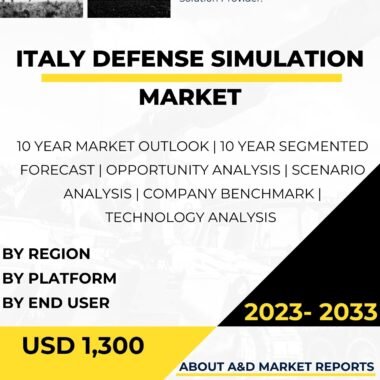Description
The Malaysia Defense Training and Simulator Market:
The defense training and simulator market in Malaysia have witnessed significant growth and transformation in recent years, reflecting the country’s commitment to enhancing its military capabilities and preparedness. As a strategically located nation in Southeast Asia, Malaysia faces a range of security challenges, and its armed forces play a crucial role in maintaining regional stability. The adoption of advanced training and simulation technologies has become essential to ensure that the military is well-equipped, skilled, and ready to respond effectively to evolving threats.
One of the primary drivers of the defense training and simulator market in Malaysia is the government’s recognition of the importance of continuous and realistic training for its military personnel. The dynamic and unpredictable nature of modern warfare demands that soldiers, sailors, airmen, and other defense personnel possess the necessary skills and expertise to adapt quickly to diverse and complex scenarios. Training and simulation technologies offer a safe and cost-effective way to provide hands-on experience and experiential learning, allowing military personnel to hone their tactical skills, decision-making abilities, and teamwork in various simulated environments.
The Malaysian government’s focus on modernizing its defense forces has led to substantial investments in training and simulation infrastructure. Advanced training facilities, equipped with cutting-edge simulators, have been established to cater to the diverse needs of different branches of the military. These facilities include virtual reality (VR) simulators for infantry and urban warfare training, flight simulators for pilots, and maritime simulators for naval personnel. Such investments have significantly improved the quality and effectiveness of training programs, resulting in a more capable and confident military force.
Additionally, international collaborations and partnerships have played a vital role in expanding the defense training and simulator market in Malaysia. The government has actively sought cooperation with leading global defense companies and training institutions to gain access to state-of-the-art training technologies and expertise. These collaborations have facilitated the transfer of knowledge, best practices, and technology, enabling the development of world-class training and simulation solutions within the country.
Furthermore, Malaysia’s commitment to research and development (R&D) has led to the emergence of indigenous defense training and simulation solutions. Local defense companies and research institutions have been encouraged to innovate and develop their training and simulation technologies. This approach not only promotes self-reliance but also stimulates economic growth and job creation in the defense sector.
The defense training and simulator market in Malaysia extends beyond traditional military applications. The country’s interest in disaster preparedness and crisis management has led to the adoption of simulation technologies for civilian agencies as well. Police forces, emergency services, and other first responders benefit from realistic training scenarios that allow them to practice their response strategies to various crisis situations effectively.
However, the defense training and simulator market in Malaysia also faces challenges. Budget constraints and limited resources can impact the scale and scope of training programs and simulator acquisitions. Balancing the allocation of funds between defense procurement, training, and other priorities remains a continuous challenge for the government.
Furthermore, maintaining and upgrading existing training and simulation facilities require ongoing investments, particularly as technology rapidly evolves. The industry must stay abreast of the latest advancements in simulation, virtual reality, and artificial intelligence to ensure that training remains relevant and effective.
Cybersecurity is another critical concern in the defense training and simulator market. As training systems become increasingly connected to networks and cloud infrastructure, they become potential targets for cyber threats. Ensuring the security and integrity of these systems is paramount to protecting sensitive military data and maintaining a high level of operational readiness.
Looking ahead, the defense training and simulator market in Malaysia is expected to continue its growth trajectory. The government’s commitment to modernizing the armed forces and investing in defense infrastructure will drive further advancements in training and simulation technologies. Additionally, as Malaysia seeks to enhance its role in regional security cooperation and peacekeeping missions, the demand for sophisticated and versatile training and simulation solutions will likely increase.
Moreover, emerging technologies such as augmented reality (AR), mixed reality (MR), and AI-driven simulations hold the potential to revolutionize defense training and simulation further. These technologies can provide even more realistic and immersive training experiences, allowing military personnel to prepare for a wide range of scenarios, from conventional warfare to asymmetric threats.
In conclusion, the defense training and simulator market in Malaysia have experienced remarkable growth and transformation. The government’s emphasis on modernizing the armed forces and investing in advanced training technologies has yielded significant improvements in military readiness and capabilities. By fostering international collaborations and supporting domestic research and development, Malaysia has positioned itself as a regional player in defense training and simulation. However, challenges related to budget constraints, technology upgrades, and cybersecurity must be addressed proactively to sustain and enhance the growth of the defense training and simulator market in the years to come.




